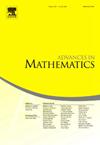Solution of all quartic matrix models
IF 1.5
1区 数学
Q1 MATHEMATICS
引用次数: 0
Abstract
We consider the quartic analogue of the Kontsevich model, which is defined by a measure on Hermitian -matrices, where E is any positive matrix and λ a scalar. It was previously established that the large-N limit of the second moment (the planar two-point function) satisfies a non-linear integral equation. By employing tools from complex analysis, in particular the Lagrange-Bürmann inversion formula, we identify the exact solution of this non-linear problem, both for finite N and for a large-N limit to unbounded operators E of spectral dimension ≤4. For finite N, the two-point function is a rational function evaluated at the preimages of another rational function R constructed from the spectrum of E. Subsequent work has constructed from this formula a family of meromorphic differentials which obey blobbed topological recursion. For unbounded operators E, the renormalised two-point function is given by an integral formula involving a regularisation of R. This allowed a proof, in subsequent work, that the -model on noncommutative Moyal space does not have a triviality problem.
所有四次矩阵模型的解
我们考虑Kontsevich模型的四次模拟,该模型由一个在hermite N×N-matrices上的测度exp (- NTr(EΦ2+(λ/4)Φ4))dΦ定义,其中E是任意正矩阵和λ a标量。先前建立了二阶矩(平面两点函数)的大n极限满足非线性积分方程。利用复变分析的工具,特别是拉格朗日- b rmann反演公式,我们确定了这一非线性问题的精确解,既适用于有限N,也适用于谱维≤4的无界算子E的大N极限。对于有限N,两点函数是一个有理函数,在e的谱构造的另一个有理函数R的原像处求值。随后的工作从这个公式构造了一个遵从团状拓扑递推的亚纯微分族ωg, N。对于无界算子E,重整的两点函数由一个包含正则化r的积分公式给出,这使得在后续的工作中证明了在非交换模空间上的λΦ44-model不存在琐碎性问题。
本文章由计算机程序翻译,如有差异,请以英文原文为准。
求助全文
约1分钟内获得全文
求助全文
来源期刊

Advances in Mathematics
数学-数学
CiteScore
2.80
自引率
5.90%
发文量
497
审稿时长
7.5 months
期刊介绍:
Emphasizing contributions that represent significant advances in all areas of pure mathematics, Advances in Mathematics provides research mathematicians with an effective medium for communicating important recent developments in their areas of specialization to colleagues and to scientists in related disciplines.
 求助内容:
求助内容: 应助结果提醒方式:
应助结果提醒方式:


